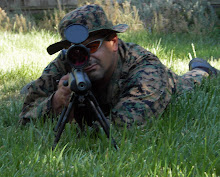Of the several things you need to do to properly align your telescope, I previously posted about balancing via the use of a leveling system... this one covers another important aspect; balancing your telescope.
When you pull the scope out of the box and use *only* the accessories provided in the box, which may include the scope, tripod, small star diagonal, small finder-scope and maybe one eyepiece, it is likely that all the equipment will balance fairly well. When you start adding new accessories like I have, you will start to see that the scope will become unbalanced and heavier in either the 'front' or 'rear' ends of the scope. Additionally, you may find that now your scope is heavier on one side or the other, but that is for a different post, this one only covers the front / rear balance issues.
So now you have an interesting challenge, you need to add weight to either the front / rear of the scope to balance it out. You do have some options, I chose to head to Starizona.com to see what counterweight options they had available. Looking at their storefront I saw the following options:
--> top weight set
--> bottom weight set
--> complete weight set
Then I was faced with the inevitable question, what should I order? Without any documentation to guide me to a decision, I opted for the complete weight set.. I couldn't possibly go wrong there! (famous last words)
So in comes my order, I read the instructions and placed them on my scope.. now to do my balancing act.
I immediately installed the top weight (only 1 to start) and the bottom rail (with 1 disc). I was able to almost immediately balance vertically by moving the bottom rail to a rearward position (see image below).

Notice the weight on top as well as the position of the weight disc on the bottom rail, this position allowed me to get a perfect balance vertically, but unfortunately not horizontally. So I would reposition the weights horizontally to get balance and it would negate my vertical balance, leaving the scope unbalanced in the vertical position again... just when this looked so simple... ;-)
I ended up taking off the upper / lower weights and observed the scope balance more carefully. The scope was pretty heavy in the rearward upper position, placing a weight on top made horizontal balance easy, but didn't help the vertical balance at all. So noting the above, I decided to not put a counterweight on the top at all and instead move the bottom counterweight into a more forward position.

Moving the bottom counterweight back and forth, I was eventually able to find the sweetspot for both vertical and horizontal balance.

Now my scope is perfectly balanced in both the vertical as well as horizontal positions!
One other thing that I had to work on for the balance was the position / distribution of the weights on the bottom rail not only for balance but also to ensure that I could clear the CPC base with the bottom counterweight. I was able to find and mark the position appropriate to this particular visual setup.
As I use some other accessories like cameras, etc.. I had to additionally put other marks on the bottom rail so I could know where exact balance was for these other configurations (eg: imaging).

Of note: In retrospect, now knowing my scopes balance points, I would have probably just ordered the bottom rail and weight set, saving myself $79.00 (plus shipping / tax). Of course your mileage and setup may vary... understanding your setup and observing your specific balance variables on your setup, will lead you to select the right product for you.
Happy (Photon) Hunting!

If I had it to do all over again, I would not go to "Fork, Alt-Az".
ReplyDeleteMatter of fact, I'm thinking seriously about trying to sell off my CPC1100 along with all the addons and gong to GEM and Refractors.
But, thanks very much for this well written procedure.
Jim Hawkins
TAS
Plano, TX
texfb@verizon.net